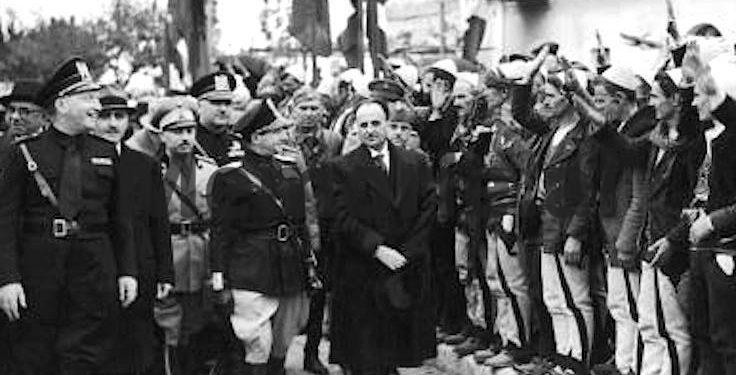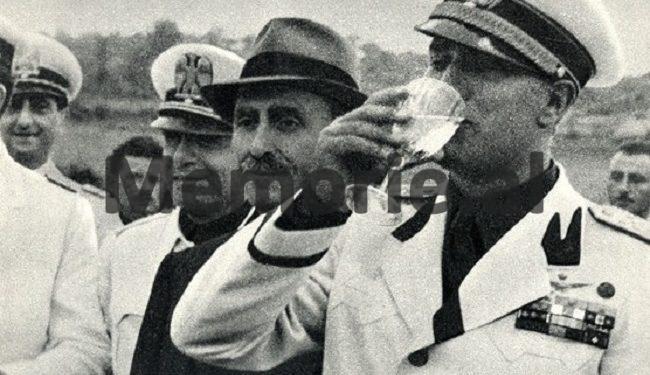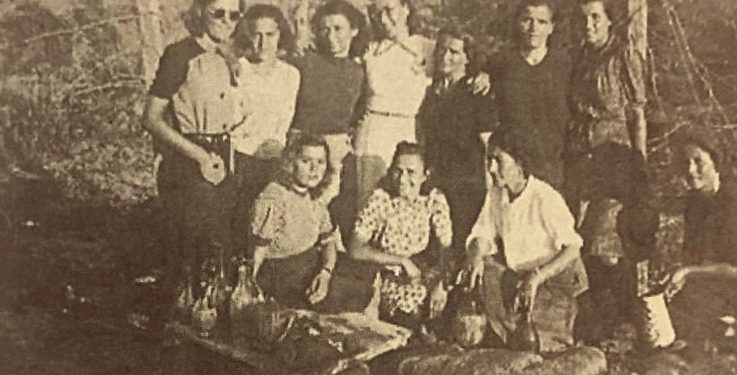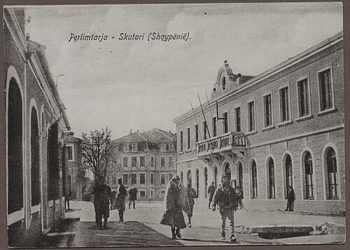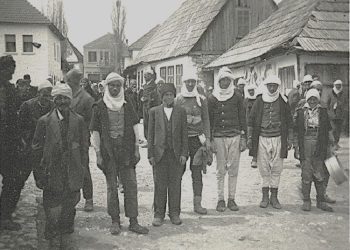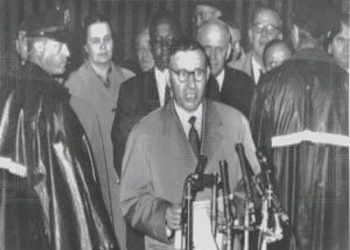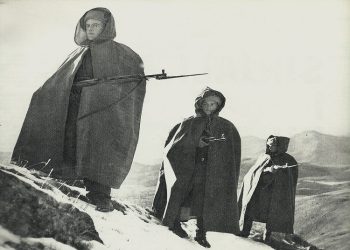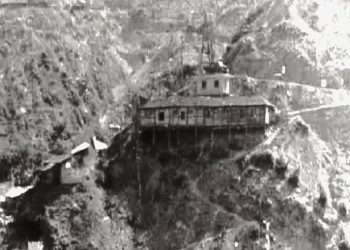By Dr. Jacopo Calussi, University of Teramo
-The fascist system of internment and the Italian occupation of Albania: A study on the relationship between the army and the population-
Memorie.al / This article will analyze the initial phase of a research regarding the Italian occupation of Albania. The purpose of the study is to highlight some aspects of the fascist occupation of the country: in particular, the existing cooperation in the field of suppression of resistance and management of different nationalities in the Albanian territory. The sources concern several military archival collections (war diaries of the occupying armies and reports on war crimes committed by the Italians between 1939 and 1943), stored in the Historical Archives of the General Staff of the Army in Rome.
In the second phase, documents from the Central State Archive (Ministry of the Interior, General Directorate of Public Security) and from the Archives of the Ministry of Foreign Affairs (in particular the fund of the Under secretariat for Albania). In this presentation, special attention will be paid to the fascist internment system in Albania and the rest of the territories occupied by Italy, with in-depth analyzes related to the various dependencies of the camps (military or police and public security) and the methods of their operation (deported population and reasons for deportment).
Entry
In this paper, I will analyze the beginning of research regarding some aspects of the Italian occupation of Albania. The purpose of the study is to highlight some special features of the fascist occupation of the country, describing the different phases experienced by the occupier and the population. The research is based on the comparison of the experiences of the conquered and the conqueror, in the case of Italian soldiers and politicians.
In fact, I completed my doctorate a few years ago, with a thesis on the government of the fascist province under the German occupation, and under the formal government of the Italian Social Republic. It was therefore very interesting to compare some of the ways in which the occupied territories were managed, through the ‘dual lenses’ of the regime’s officials and military at the turn of the ‘Italo-Allied’ armistice of 8 September 1943 and under completely opposite conditions, in the hierarchy of fascist satellite states.
However, it is worth mentioning that in the two experiences of ‘collaborationism’, there are common features, both in the treatment of the local administration, that is, of the Albanian and Italian governments after 1943, as well as in the main problems related to the world conflict, such as; rationing, management and exploitation of human and territorial resources of occupied areas, maintenance of public order, repression or agreement with resistance movements and contrasts between allied authorities, or even, as we shall see, in the management of the Jewish question.
Here we will focus on the system of internment and special surveillance of the Mussolini regime, between 1939 and 1943, the year in which, after the Italian surrender to the Anglo-American armies, the territories annexed or occupied by the Royal Army fell under the control of Wehrmacht. Then we will describe the different phases of the Italian occupation of Albania, in the light of the fascist repressive system and the law enforcement system.
Starting in 1939, with an almost bloodless occupation, the Italian government tried to achieve a certain level of Italian-Albanian cooperation, in order to exploit the mineral resources of its territories (especially chromium, in terms of the levels of oil, fascist propaganda exaggerated the extent of Albanian wells);
The creation of an executive without any popular connection and the superior monarchical institutional framework, dependent on the Italian Foreign Ministry, did not seem to prevent a moment of real development in the country; on the other hand, this extended phase was paid with the sacrifice of every democratic freedom and a growing marginalization of the Albanian population, from the highest levels of the national economy. The so-called ‘Ciano system’ was based on widespread corruption, nurtured by local elites and fascist officials themselves, who were only occasionally sanctioned and recalled, for fraud and other embezzlement.
Some bad choices in monetary matters and the resulting inflationary spiral began to undermine the relationship between the Italian occupiers and the population, as early as 1940, with prices almost doubling in just six months (77-80% in November 1939). ; In the following autumn, the disastrous Greek invasion and the counter-offensive in the middle of the Albanian territory drowned the ‘imperial’ image of Fascist Italy.
After the failure of Mussolini’s parallel war, one can actually talk about an organized Albanian resistance, this is the definition given in the war diaries of the Italian army. From January to December 1941, officials of the Ministry of the Interior, the Carabinieri and SIM, (Military Intelligence Services), reported that they had established special surveillance measures for about 21,000 Albanians; 5,600 of them were interned in concentration camps or locked up in special zones, modeled on the Fascist and Savoy frontiers.
The Greek counter-offensive on the Albanian front destroyed the image of power created by the overwhelming propaganda of the regime. The material consequences concerned the last period of the occupation as a whole, characterized since the winter of 1941 by a series of sabotage, explosive and non-explosive attacks (such as the one against Victor Emmanuel III, which failed in January of 1941), assassinations and ambushes against soldiers and officials of the Kingdom of Italy.
The fragile Albanian government could hardly be taken seriously by the population, in the wake of the criminal acts of fierce revenge commanded by the Italians and some autochthonous paramilitary formations. These became particularly popular during the government of Mustafa Kruja, especially for the acts of revenge against the partisans and the population of the southern regions and the area of Ioannina.
From 1942 onwards, especially in the territories annexed after the German occupation of Yugoslavia and Greece, it became a common norm to assign responsibility for the attack to the community residing within 1,500 meters of the scene. The same rules, two years later, would be imposed by the Wehrmacht on Italian civilians and partisans. Anyone found with a weapon in their hands or at home could be killed on the spot, while deportation concerned heads of households, even the elderly, living in places of partisan attacks.
The ‘rules’ of exile dealt with so-called ‘political offences’, committed by the local population (armed uprising, organization or participation in subversive groups and associations, bomb attacks against the occupying forces, but also incitement to desertion at work compulsory or military conscription), while additional retaliatory measures may refer to the entire population of the area between the ages of 16 and 60, held de facto as hostages to prevent further partisan attacks.
In Albania, to an increasing extent after the winter of 1941-1942, the same radical regulations, which were adopted in the territories of the former Kingdom of Yugoslavia, would be adopted to cope with an uncontrollable resistance movement. According to Rodogno, the “infamous Circular 3 C”, of March 1, 1942, a model provision for the radical suppression of rebellion in the Balkans, was adopted in every context affected by Italian occupation, with the exception of Southern France.
The circular was issued by General Roatta, commander of the Second Army, based on similar principles, the superior commander of the armed forces in Albania, General Renzo Dalmazzo, wrote to the command of COA IX and XXV, (in the sectors of Shkodra and Kosovo) on February 16, 1943: ‘Good people are arrested in village centers. Revolta should be kept available to be sent to concentration camps, for possible later reprisals’.
A special case for the exiled population in the Balkans was that of Pirzio Biroli, commander of the armed forces in Montenegro and after the war, indicted for war crimes in the area of his command. In the summer of 1941, after the Montenegrin Partisan uprising, the general gave his officers and soldiers the freedom to destroy the houses closest to the sites of the uprising, expel every adult male in the community, and kill any suspected Partisan, in place.
This policy caused several thousand Montenegrins to be sent to Albanian concentration camps. A year later, the general himself had to understand the negative consequences of this strategy, which was completely ineffective against the rebellion, as he ordered the establishment of a review commission, civil and military. As a result, 3,000 former internees were able to return to Montenegro from the Albanian camps.
On the contrary, 3,000 to 5,000 Montenegrins remained within the borders of Albania. About 1,597 Albanian prisoners of war were added to these, interned after the invasion, to be released in 1942, according to agreements with the Albanian government. From the summer of ’42, the number of Albanian internees increased with the increase in resistance activity, which was increasingly organized, and consequently with the radicalism of the Italian repression.
In particular, at least four internment camps are known for partisan fighters: Berati, Kavaja and Shijaku; two ascertained places of internment, Shiroka (VP) and Berati, where 150 Jews, probably Montenegrins, lived temporarily. In total, according to the estimates of Capogreco, Rodogno and Conti, the number of persons interned for ‘political’ reasons, or to be included in the labor battalions, reached a maximum of 25 to 30,000, of which at least 5,000 were non-Albanian in ethnicity or origin.
The camps about which we have some information were managed by the Italian armed forces, with the employment of the Royal Carabinieri and only partially with the cooperation of the local prefect. In terms of public order management, the increasingly numerous but increasingly less effective armed forces in the face of guerrilla warfare between 1942 and 1943 were joined by the Public Security Services of the Ministry of the Interior, in a competitive position in relation to the army services and Militia Information Offices, united with the Italian 9th Army in Albania, but with its own intelligence services.
The conflict between these centers of power, to which the Albanian administrative structure was added, became an increasingly harmful factor for maintaining control over the territory. The replacement of Jacomoni by Parian and the first agreements with some of the armed resistance movements led to a temporary truce in the winter of ’43. The following spring and summer, on the contrary, saw a revival of the Italian anti-partisan war, increasingly similar in methods and strategies to the anti-bandit units of the Reich, and consequently the reaction of the National Liberation Movement and partly of the ‘National Front’.
In July 1943, with the Mallakastra massacre, the Royal Italian Army was guilty of the worst war crimes committed in Albania; The fall of Mussolini and the ‘dissolution’ of the army in the following September led to a partial settlement of accounts with the Italians by the partisans and the dramatic choice of cooperation, with the new German masters, or against them in arms.
A small mention must be made of the Jewish question. In theory, the immigration and residence of members of the Jewish communities in ‘Greater Albania’ (meaning the expansion of the nation’s borders after May 1941) was banned by order of General Jacomoni. Neither Italian nor Albanian officials showed strict respect for the rule, especially since the Albanian Jewish population numbered only a few hundred members.
Moreover, although not characterized by humanitarian goals, some senior Italian officers did not particularly appreciate the National Socialist pressure to hand over the Balkan Jews and were able to use their autonomy to prevent the deportation of several thousand Jews, from the Albanian and former Yugoslav territories. In other cases, officers and commanders cooperated extensively in the Holocaust in Croatia and the Italian-controlled areas of Bosnia.
This position must be interpreted in the light of the conflicts of competences between the allied authorities and the desire of the Italian armed forces to defend their role. Regarding the camps dedicated to Jewish internment, we have mentioned the Berat camp, as a place of residence for 150 Jews from Cimmeria, Montenegro and the territory of the Albanian Kingdom; to this were added Kruja and Kavaja, and the Pristina camp with a total of 500 Kosovar Jews, or from the territories of former Yugoslavia exiled, under Italian control, remembering that the Italians controlled only half of historical Kosovo, with the exception, in Germany, of the Zone of Mitrovica.
The Albanian population has cooperated very little in the denunciation and arrest of Jews born inside and outside the borders of 1939. According to an estimate after the end of the conflict, the number of Jews in Kosovo, who died as a result of violence or deportation, did not reach 80 people. However, the initial strategy of internment, carried out by Mussolini’s men, could be used by the German armed forces and police in the phase after September 8, 1943, with some dramatic results, for the Jewish population of the former Kingdom of Yugoslavia.
To conclude, further research on collaborationism, or rather cooperation, between the Italian and Albanian sides during the first three years of the war, may better explain the authority relations that existed between the Allies and the invaders; to complement this, it should in no way result in rigorous moral judgement, partly tied to the very definition of collaborationism; Among the Italians, a kind of crime of the Military Penal Code of War.
The methodology of scientific research, associated with greater accessibility of the Italian military and diplomatic archives, are more than sufficient instruments, to give dignity to an object of study often marginalized by European and Italian historiography, on the world wars: in this way , positive results can be achieved in the study of fascisms and the hypothetical continental order that inspired their changing strategies. Memorie.al






